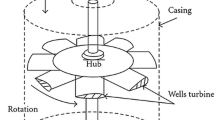Abstract
Wells turbine has the cascade whose stagger angle is 90°, namely the blades are perpendicular to the axial velocity. Good performance is required from 0° to 90° angle of attack because the turbine is operated in the oscillating airflow produced with wave energy. Furthermore, very interesting and complex flows are experimentally observed by the oil film method for large angles of attack where the performance is strongly influenced, especially, the self-starting. This paper tries to analyze the mechanism of these three-dimensional flows around the turbine with the flow visualization and the numerical analysis, focusing on the off-design condition.
Similar content being viewed by others
References
Patankar, S. V., Numerical heat transfer and fluid flow, (1980), McGraw-Hill, New York.
Raghunathan, S., The Wells Air Turbine for Wave Energy Conversion, Prog. Aerospace Sci., 31 (1995), 335–386.
Rhie, C. M. and Chow, W. L., Numerical Study of the Turbulent Flow Past on Airfoil with Trailing Edge Separation, AIAA J, 21-11 (1983), 1525–1532.
Suzuki, M. and Arakawa, C., Guide Vanes Effect of Wells Turbine for Wave Power Generator, Int J Offshore and Polar Eng, ISOPE, 10-2 (2000), 153–159.
Suzuki, M., Fleig, O. and Arakawa, C., Comparison of Suitability of Different CFD Codes for Wind Turbine Blades, Proc of 5th JSME-KSME Fluids Eng Conf (Nagoya, Japan), JSME, (2002), 1359-1364, CD-ROM.
Suzuki, M. and Arakawa, C., Investigation of Calculation Accuracy and Domain Size around Isolate Airfoil, Proc 17th Symposium Computational Fluid Dynamics, JSFM, D1-6 (2003), CD-ROM, (in Japanese).
Watterson, J. K. and Raghunathan, S., Computed Effects of Tip Clearance on Wells Turbine Performance, 35th Aerospace Sci Mtg and Exh (Reno, NV), AIAA Paper, 97-0994 (1997).
Author information
Authors and Affiliations
Corresponding author
Additional information
Masami Suzuki: He received his BEng in Mechanical Engineering in 1976 from Tokyo Denki University. He also received his D.Eng. in Mechanical Engineering in 2002 from the University of Tokyo. He worked in Department of Mechanical Engineering, the University of Tokyo as a technical researcher in 1972. He works in Department of Mechanical Engineering, the University of Tokyo as a research associate since 1984. His research interests are Wave Energy Converting System, Computational Fluid Dynamics and Turbomachnery.
Chuichi Arakawa: He received his MEng in Mechanical Engineering in 1976 from the University of Tokyo. He also received his D.Eng. in Mechanical Engineering in 1980 from the University of Tokyo. He worked in Department of Mechanical Engineering, the University of Tokyo as a Lecturer in 1980, as an associate professor in 1981, and a professor since 1996. He worked in the University of Karlsruhe as a researcher in 1985-1986. His research interests are Computational Fluid Dynamics, Wind Turbine, and Energy Economics Simulation.
Rights and permissions
About this article
Cite this article
Suzuki, M., Arakawa, C. Flow on blades of wells turbine for wave power generation. J Vis 9, 83–90 (2006). https://doi.org/10.1007/BF03181571
Received:
Accepted:
Issue Date:
DOI: https://doi.org/10.1007/BF03181571




